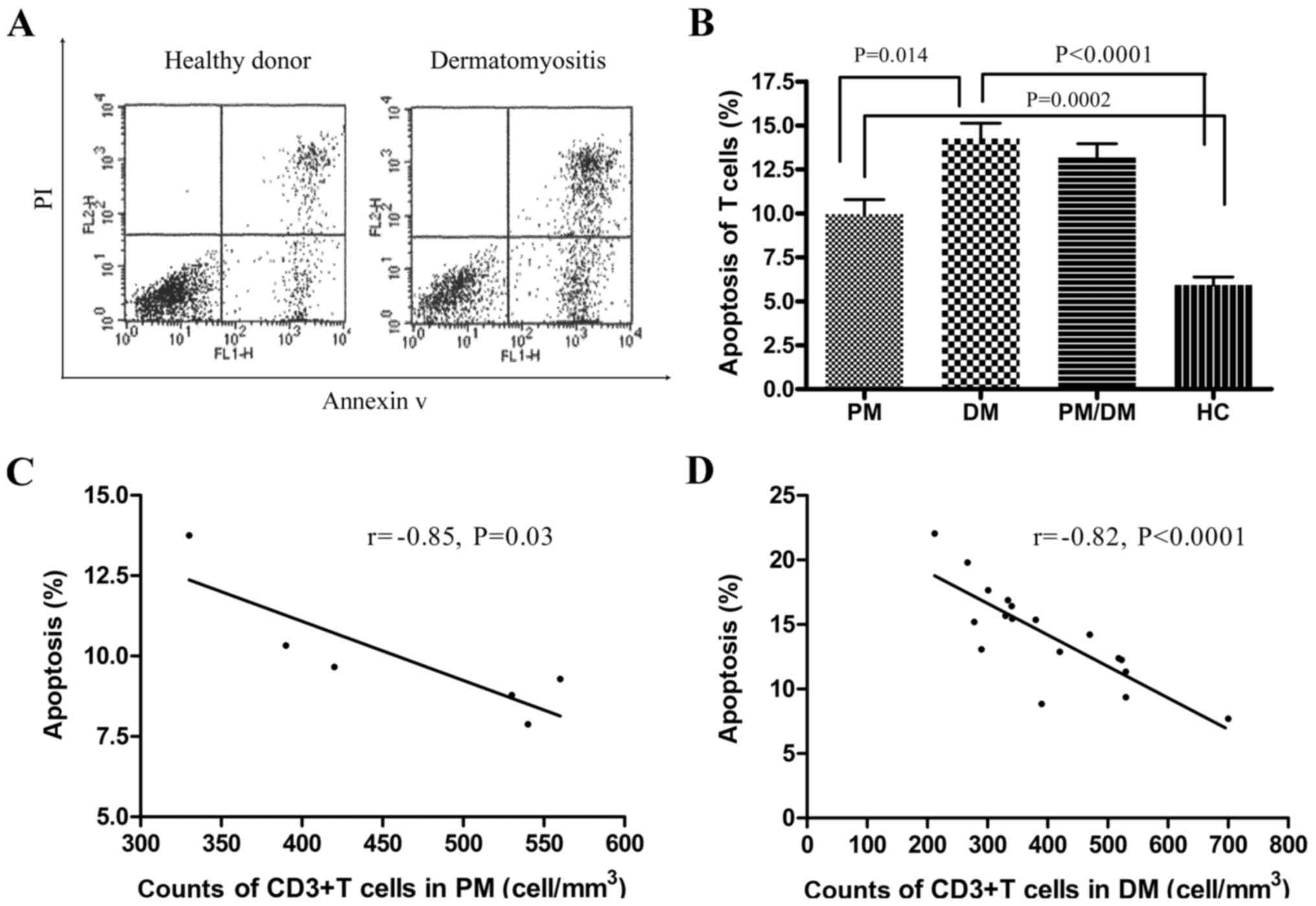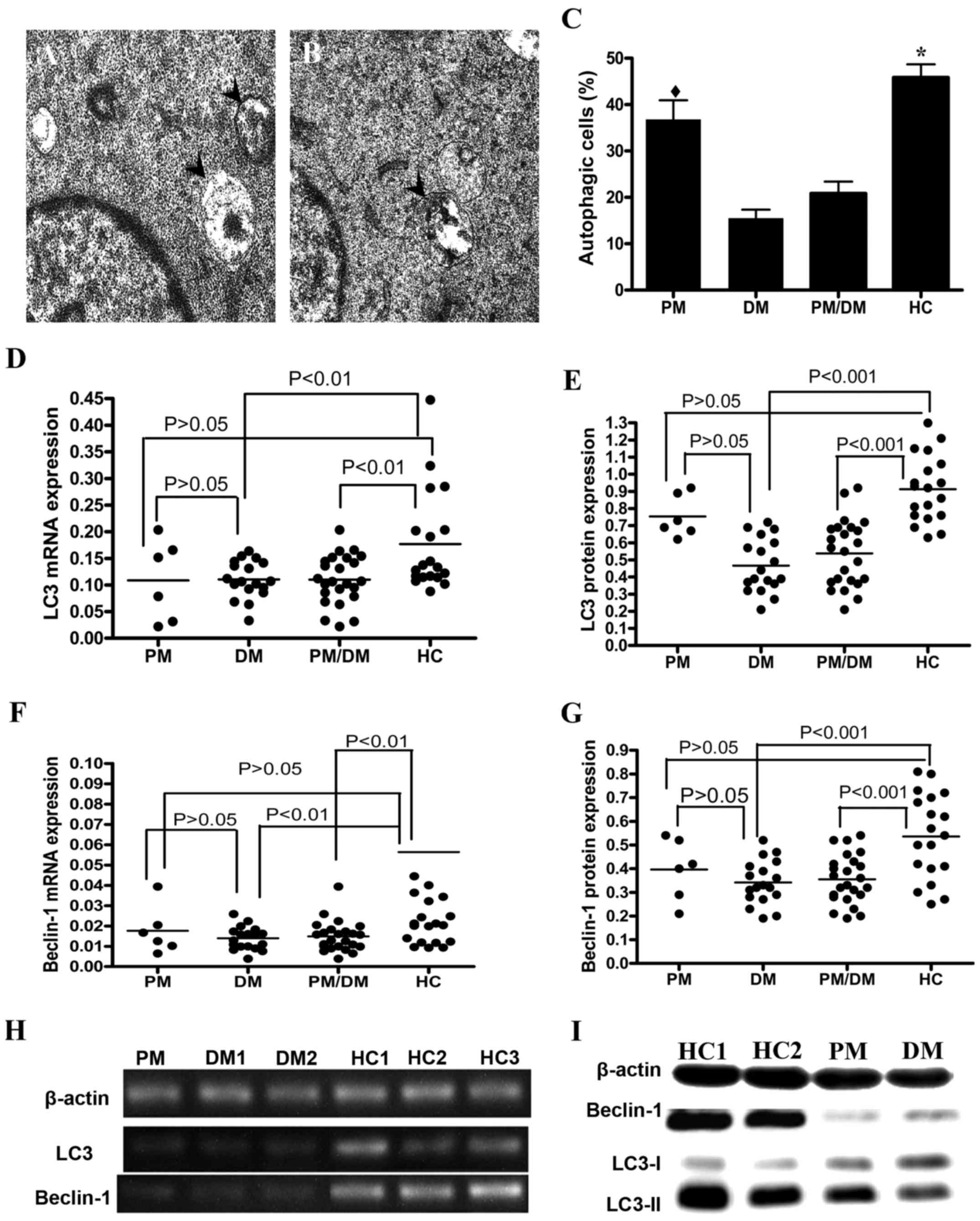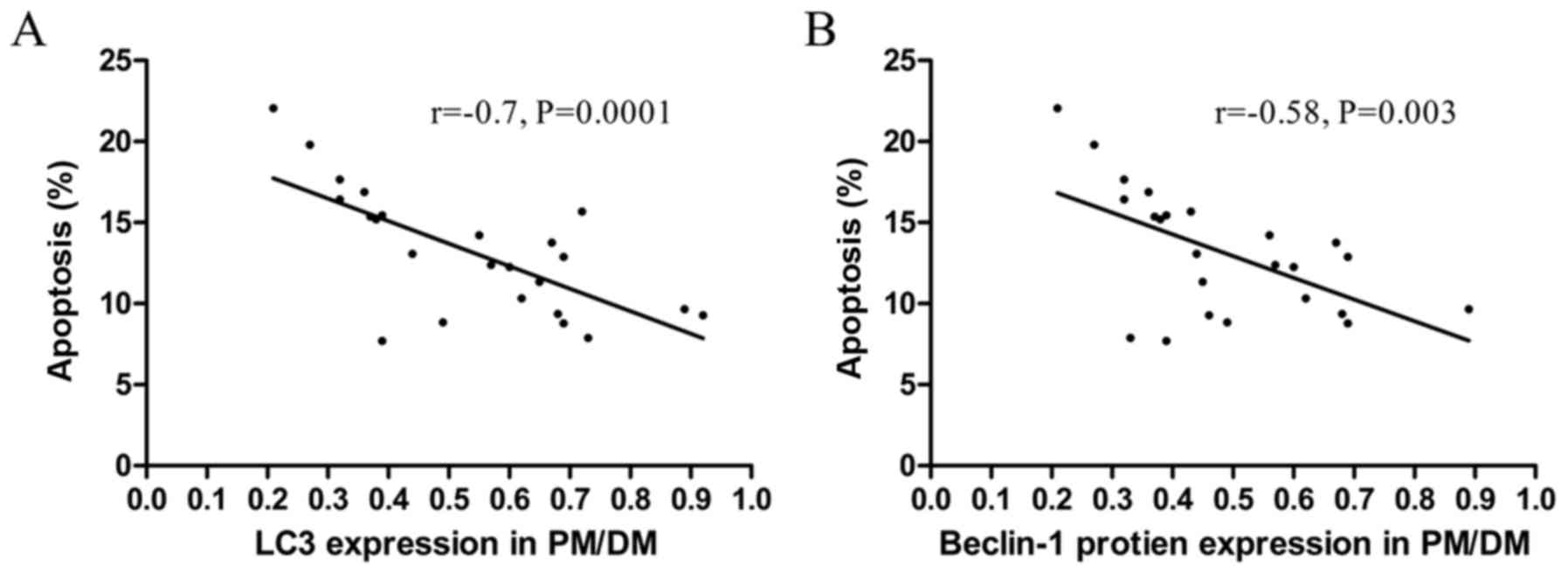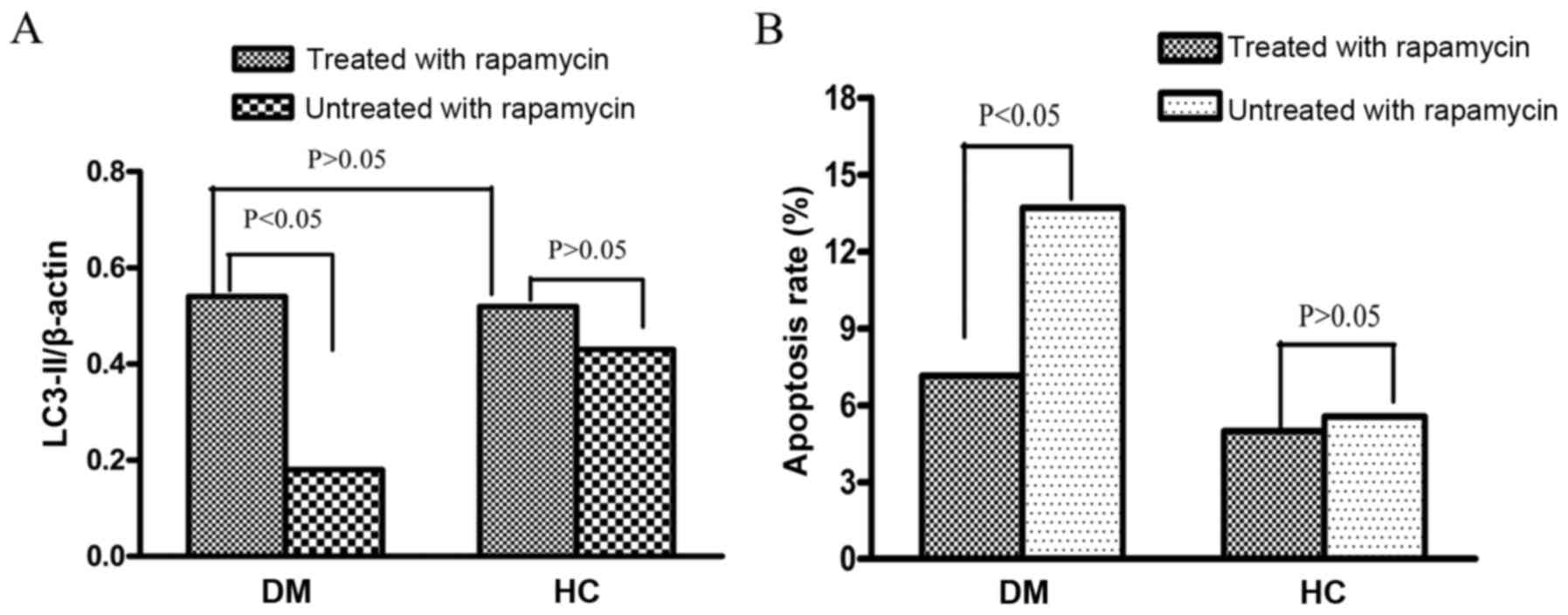|
1
|
Malmström V, Venalis P and Albrecht I: T
cells in myositis. Arthritis Res Ther. 14:2302012. View Article : Google Scholar : PubMed/NCBI
|
|
2
|
Venalis P and Lundberg IE: Immune
mechanisms in polymyositis and dermatomyositis and potential
targets for therapy. Rheumatology (Oxford). 53:397–405. 2014.
View Article : Google Scholar : PubMed/NCBI
|
|
3
|
Wang DX, Lu X, Zu N, Lin B, Wang LY, Shu
XM, Ma L and Wang GC: Clinical significance of peripheral blood
lymphocyte subsets in patients with polymyositis and
dermatomyositis. Clin Rheumatol. 31:1691–1697. 2012. View Article : Google Scholar : PubMed/NCBI
|
|
4
|
Ishii W, Matsuda M, Shimojima Y, Itoh S,
Sumida T and Ikeda S: Flow cytometric analysis of lymphocyte
subpopulations and TH1/TH2 balance in patients with polymyositis
and dermatomyositis. Intern Med. 47:1593–1599. 2008. View Article : Google Scholar : PubMed/NCBI
|
|
5
|
Aleksza M, Szegedi A, Antal-Szalmás P,
Irinyi B, Gergely L, Ponyi A, Hunyadi J, Sipka S, Zeher M, Szegedi
G and Dankó K: Altered cytokine expression of peripheral blood
lymphocytes in polymyositis and dermatomyositis. Ann Rheum Dis.
64:1485–1489. 2005. View Article : Google Scholar : PubMed/NCBI
|
|
6
|
Viguier M, Fouéré S, de la Salmonière P,
Rabian C, Lebbe C, Dubertret L, Morel P and Bachelez H: Peripheral
blood lymphocyte subset counts in patients with dermatomyositis:
Clinical correlations and changes following therapy. Medicine
(Baltimore). 82:82–86. 2003. View Article : Google Scholar : PubMed/NCBI
|
|
7
|
Eisenstein DM, O'Gorman MR and Pachman LM:
Correlations between change in disease activity and changes in
peripheral blood lymphocyte subsets in patients with juvenile
dermatomyositis. J Rheumatol. 24:1830–1832. 1997.PubMed/NCBI
|
|
8
|
Ishida T, Matsumoto Y, Ohashi M and Sasaki
R: Analysis of lymphocyte subpopulations in peripheral blood in
adult and juvenile cases of dermatomyositis. J Dermatol. 20:30–34.
1993. View Article : Google Scholar : PubMed/NCBI
|
|
9
|
Cope AP, Schulze-Koops H and Aringer M:
The central role of T cells in rheumatoid arthritis. Clin Exp
Rhuematol. 25 5 Suppl 46:S4–S11. 2007.
|
|
10
|
La Cava A: Lupus and T cells. Lupus.
18:196–201. 2009. View Article : Google Scholar : PubMed/NCBI
|
|
11
|
Wehrens EJ, Prakken BJ and van Wijk F: T
cells out of control-impaired immune regulation in the inflame
joint. Nat Rev Rheumatol. 9:34–42. 2013. View Article : Google Scholar : PubMed/NCBI
|
|
12
|
Klionsky DJ and Emr SD: Autophagy as a
regulated pathway of cellular degradation. Science. 290:1717–1721.
2000. View Article : Google Scholar : PubMed/NCBI
|
|
13
|
Pope RM: Apoptosis as a therapeutic tool
in rheumatoid arthritis. Nat Rev Immunol. 2:527–535. 2002.
View Article : Google Scholar : PubMed/NCBI
|
|
14
|
Citro A, Barnaba V and Martini H: From T
cell apoptosis to chronic immune activation in inflammatory
diseases. Int Arch Allergy Immunol. 164:140–146. 2014. View Article : Google Scholar : PubMed/NCBI
|
|
15
|
Choi AM, Ryter SW and Levine B: Autophagy
in human health and disease. N Engl J Med. 368:651–662. 2013.
View Article : Google Scholar : PubMed/NCBI
|
|
16
|
Lleo A, Invernizzi P, Selmi C, Coppel RL,
Alpini G, Podda M, Mackay IR and Gershwin ME: Autophagy:
Highlighting a novel player in the autoimmunity scenario. J
Autoimmun. 29:61–68. 2007. View Article : Google Scholar : PubMed/NCBI
|
|
17
|
Bhattacharya A and Eissa NT: Autophagy and
autoimmunity crosstalks. Front Immunol. 4:882013. View Article : Google Scholar : PubMed/NCBI
|
|
18
|
Kuballa P, Nolte WM, Castoreno AB and
Xavier RJ: Autophagy and the immune system. Annu Rev Immunol.
30:611–646. 2012. View Article : Google Scholar : PubMed/NCBI
|
|
19
|
Ma Y, Galluzzi L, Zitvogel L and Kroemer
G: Autohagy and cellular immune responses. Immunity. 39:211–227.
2013. View Article : Google Scholar : PubMed/NCBI
|
|
20
|
Han JW, Zheng HF, Cui Y, Sun LD, Ye DQ, Hu
Z, Xu JH, Cai ZM, Huang W, Zhao GP, et al: Genome-wide association
study in a Chinese Han population identifies nine new
susceptibility loci for systemic lupus erythematosus. Nat Genet.
41:1234–1237. 2009. View
Article : Google Scholar : PubMed/NCBI
|
|
21
|
International Consortium for Systemic
Lupus Erythematosus Genetics (SLEGEN), ; Harley JB,
Alarcón-Riquelme ME, Criswell LA, Jacob CO, Kimberly RP, Moser KL,
Tsao BP, Vyse TJ, Langefeld CD, et al: Genome-wide association scan
in women with systemic lupus erythematosus identifies
susceptibility variants in ITGAM, PXK, KIAA1542 and other loci. Nat
Genet. 40:204–210. 2008. View
Article : Google Scholar : PubMed/NCBI
|
|
22
|
Zhou XJ, Lu XL, Lv JC, Yang HZ, Qin LX,
Zhao MH, Su Y, Li ZG and Zhang H: Genetic association of PRDM1-ATG5
intergenic region and autophagy with systemic lupus erythematosus
in a Chinese population. Ann Rheum Dis. 70:1330–1337. 2011.
View Article : Google Scholar : PubMed/NCBI
|
|
23
|
Raychaudhuri S, Thomson BP, Remmers EF,
Eyre S, Hinks A, Guiducci C, Catanese JJ, Xie G, Stahl EA, Chen R,
et al: Genetic variants at CD28, PRDM1 and CD2/CD58 are associated
with rheumatoid arthritis risk. Nat Genet. 41:1313–1318. 2009.
View Article : Google Scholar : PubMed/NCBI
|
|
24
|
Parkes M, Barrett JC, Prescott NJ,
Tremelling M, Anderson CA, Fisher SA, Roberts RG, Nimmo ER,
Cummings FR, Soars D, et al: Sequence variants in the autophagy
gene IRGM and multiple other replicating loci contribute to Crohn's
disease susceptibility. Nat Genet. 39:830–832. 2007. View Article : Google Scholar : PubMed/NCBI
|
|
25
|
Temiz P, Weihl CC and Pestronk A:
Inflammatory myopathies with mitochondrial pathology and protein
aggregates. J Neurol Sci. 278:25–29. 2009. View Article : Google Scholar : PubMed/NCBI
|
|
26
|
Nogalska A, D'Agostino C, Terracciano C,
Engel WK and Askanas V: Impaired autophagy in sporadic
inclusion-body myositis and in endoplasmic reticulum
stress-provoked cultured human muscle fibers. Am J Pathol.
177:1377–1387. 2010. View Article : Google Scholar : PubMed/NCBI
|
|
27
|
Alger HM, Raben N, Pistilli E, Francia DL,
Rawat R, Getnet D, Ghimbovschi S, Chen YW, Lundberg IE and Nagaraju
K: The role of TRAIL in mediating autophagy in myositis skeletal
muscle: A potential nonimmune mechanism of muscle damage. Arthritis
Rheum. 63:3448–3457. 2011. View Article : Google Scholar : PubMed/NCBI
|
|
28
|
Jia W and He YW: Temporal regulation of
intracellular organelle homeostasis in T lymphocytes by autophagy.
J Immunol. 186:5313–5322. 2011. View Article : Google Scholar : PubMed/NCBI
|
|
29
|
Bohan A and Peter JB: Polymyositis and
dermatomyositis (first of two parts). N Engl J Med. 292:344–347.
1975. View Article : Google Scholar : PubMed/NCBI
|
|
30
|
Bohan A and Peter JB: Polymyositis and
dermatomyositis (second of two parts). N Engl J Med. 292:403–407.
1975. View Article : Google Scholar : PubMed/NCBI
|
|
31
|
Hoogendijk JE, Amato AA, Lecky BR, Choy
EH, Lundberg IE, Rose MR, Vencovsky J, de Visser M and Hughes RA:
119th ENMC international workshop: Trial design in adult idiopathic
inflammatory myopathies, with the exception of inclusion body
myositis, 10–12 October 2003, Naarden, The Netherlands. Neuromuscul
Disord. 14:337–345. 2004. View Article : Google Scholar : PubMed/NCBI
|
|
32
|
Livak KJ and Schmittgen TD: Analysis of
relative gene expression data using real-time quantitative PCR and
the 2(−Delta Delta C(T)) Method. Methods. 25:402–408. 2001.
View Article : Google Scholar : PubMed/NCBI
|
|
33
|
Findlay AR, Goyal NA and Mozaffar T: An
overview of polymyositis and dermatomyositis. Muscle Nerve.
51:638–656. 2015. View Article : Google Scholar : PubMed/NCBI
|
|
34
|
Mammen AL: Autoimmune myopathies:
Autoantibodies, phenotypes and pathogenesis. Nat Rev Neurol.
7:343–354. 2011. View Article : Google Scholar : PubMed/NCBI
|
|
35
|
Amato AA and Greenberg SA: Inflammatory
myopathies. Continuum (Minneap Minn). 19(6 Muscle Disease):
1615–1633. 2013.PubMed/NCBI
|
|
36
|
Suárez-Fueyo A, Bradley SJ and Tsokos GC:
T cells in systemic lupus erythematosus. Curr Opin Immunol.
43:32–38. 2016. View Article : Google Scholar : PubMed/NCBI
|
|
37
|
Wu DJ and Adamopoulos IE: Autophagy and
autoimmunity. Clin Immunol. 176:55–62. 2017. View Article : Google Scholar : PubMed/NCBI
|
|
38
|
Peng QL, Zhang YL, Shu XM, Yang HB, Zhang
L, Chen F, Lu X and Wang GC: Elevated serum levels of soluble CD163
in polymyositis and dermatomyositis: Associated with macrophage
infiltration in muscle tissue. J Rheumatol. 42:979–987. 2015.
View Article : Google Scholar : PubMed/NCBI
|
|
39
|
Fasth AE, Dastmalchi M, Rahbar A,
Salomonsson S, Pandya JM, Lindroos E, Nennesmo I, Malmberg KJ,
Söderberg-Nauclér C, Trollmo C, et al: T cell infiltrates in the
muscles of patients with dermatomyositis and polymyositis are
dominated by CD28null T cells. J Immunol. 183:4792–4799. 2009.
View Article : Google Scholar : PubMed/NCBI
|
|
40
|
Sugihara T, Sekine C, Nakae T, Kohyama K,
Harigai M, Iwakura Y, Matsumoto Y, Miyasaka N and Kohsaka H: A new
murine model to define the critical pathologic and therapeutic
mediators of polymyositis. Arthritis Rheum. 56:1304–1314. 2007.
View Article : Google Scholar : PubMed/NCBI
|
|
41
|
Espinosa-Ortega F, Gómez-Martin D,
Santana-de Anda K, Romo-Tena J, Villaseñor-Ovies P and
Alcocer-Varela J: Quantitative T cell subsets profile in peripheral
blood from patients with idiopathic inflammatory myopathies:
Tilting the balance towards proinflammatory and pro-apoptotic
subsets. Clin Exp Immunol. 179:520–528. 2015. View Article : Google Scholar : PubMed/NCBI
|
|
42
|
Dhir V, Singh AP, Aggarwal A, Naik S and
Misra R: Increased T-lymphocyte apoptosis in lupus correlates with
disease activity and may be responsible for reduced T-cell
frequency: A cross-sectional and longitudinal study. Lupus.
18:785–791. 2009. View Article : Google Scholar : PubMed/NCBI
|
|
43
|
Gros F, Arnold J, Page N, Décossas M,
Korganow AS, Martin T and Muller S: Macroautophagy is deregulated
in murine and human lupus T lymphocytes. Autophagy. 8:1113–1123.
2012. View Article : Google Scholar : PubMed/NCBI
|
|
44
|
Alessandri C, Barbati C, Vacirca D,
Piscopo P, Confaloni A, Sanchez M, Maselli A, Colasanti T, Conti F,
Truglia S, et al: T lymphocytes from patients with systemic lupus
eythematosus are resistant to induction of autophagy. FASEB J.
26:4722–4732. 2012. View Article : Google Scholar : PubMed/NCBI
|
|
45
|
Emlen W, Niebur J and Kadera R:
Accelerated in vitro apoptosis of lymphocytes from patients with
systemic lupus erythematosus. J Immunol. 152:3685–3692.
1994.PubMed/NCBI
|
|
46
|
Thorburn A: Apoptosis and autophagy:
regulatory connections between two supposedly different processes.
Apoptosis. 13:1–9. 2008. View Article : Google Scholar : PubMed/NCBI
|
|
47
|
Pua HH, Guo J, Komatsu M and He YW:
Autophagy is essential for mitochondrial clearance in mature T
lymphocytes. J Immunol. 182:4046–4055. 2009. View Article : Google Scholar : PubMed/NCBI
|
|
48
|
Kovacs JR, Li C, Yang Q, Li G, Garcia IG,
Ju S, Roodman DG, Windle JJ, Zhang X and Lu B: Autophagy promotes
T-cell survival through degradation of proteins of the cell death
machinery. Cell Death Differ. 19:144–152. 2012. View Article : Google Scholar : PubMed/NCBI
|
|
49
|
Valdor R and Macian F: Autophagy and the
regulation of the immune response. Pharmacol Res. 66:475–483. 2012.
View Article : Google Scholar : PubMed/NCBI
|


















